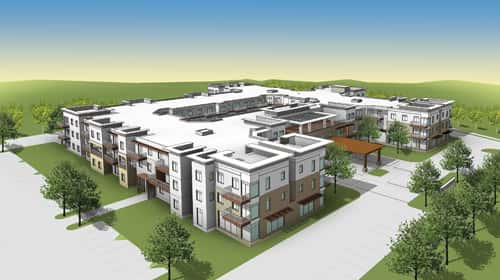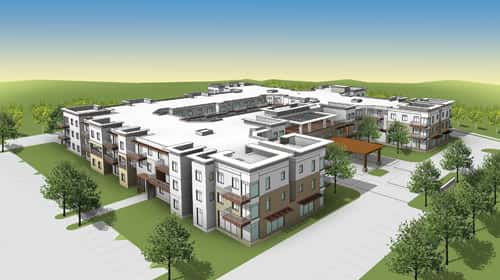 Responding to a severe lack of affordable housing in Napa County, several developers are moving forward to help build living spaces for those who need it most.
Responding to a severe lack of affordable housing in Napa County, several developers are moving forward to help build living spaces for those who need it most.
The Valley View senior housing project at 31 Theresa Avenue in American Canyon, expected to start construction this month, will set aside 22 of its 70 units for veterans and homeless veterans 55 years of age and older. The rental subsidy for homeless veterans is being provided by the U.S. Department of Housing and Urban Development’s Veterans Affairs Supportive Housing (VASH) program.
“VASH will work together with the Department of Veterans Affairs and the Napa County Housing Authority to identify veterans who qualify, based on their income and veteran status,” explains Aubra Levine, associate director of housing development for Berkeley-based Satellite Affordable Housing Associates (SAHA), the developer of the project. “We were fortunate to receive this funding.”
Some additional funding for the project came from California Proposition 41, the California Veterans Housing and Homeless Prevention Bond Act, approved by voters in 2014. At that time the proposition authorized $600 million in bonds to provide multifamily housing to low-income vets and supportive housing for homeless vets.
SAHA will create a confidential office space at Valley View where we hope and anticipate a full-time case manager from the Department of Veterans Affairs can assist with the needs of the resident veterans, says Levine. When the facility is completed, SAHA will manage the property, as it does at more than 50 other affordable housing projects it has developed in northern California, including Valley Oaks in Sonoma and Petaluma Avenue Homes in Sebastopol.
The Valley View units will be a mix of one-bedroom, one-story cottages grouped together as duplexes and triplexes, along with an additional two-story building of 12 units. All residents must be 55 and older with incomes between 30 and 60 percent of the area median income (AMI).
Good neighbors, green building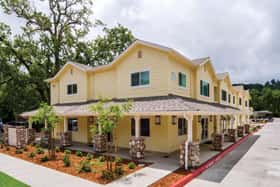
SAHA has selected Midstate Construction of Petaluma to build Valley View. Construction costs are estimated at approximately $16.5 million, with completion expected by the summer of 2018.
“Our financing requires that we break ground on Valley View this spring, rain or shine,” says Levine. “Now that we’ve secured all of our funding, which came from seven different sources, we can move forward. SAHA has a good track record of finishing projects on time.”
There was little opposition to the Valley View development when SAHA first proposed it in 2013, according to Levine. “I had the good fortune of leading the community engagement process when we first announced the project. I spoke at American Canyon City Council meetings many times, and members of the community received the project well and were excited about it.”
To help drive home SAHA’s “good neighbor” reputation, Levine encouraged American Canyon residents to check out the 10-year-old SAHA-managed Valley Oaks development on Lyon Street in Sonoma. “One man took us up on that challenge and went to see it for himself. He was pleased to note that we’re caring landlords and good stewards of that property, and are in it for the long term. We’re invested in creating durable and sustainable housing that looks good and that people want to live near.”
Levine says SAHA hopes to receive a GreenPoint certification of the project from Build It Green, a California-based nonprofit organization that promotes green building.
Funding climate is challenging
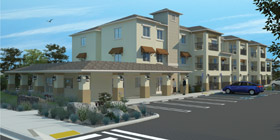 Securing all the funding for the Valley View project was not without challenges. “The financing climate is very limited now, especially at the federal level,” says Levine. “But it’s competitive at every level and particularly in the northern part of the state.”
Securing all the funding for the Valley View project was not without challenges. “The financing climate is very limited now, especially at the federal level,” says Levine. “But it’s competitive at every level and particularly in the northern part of the state.”
One contentious affordable housing project proposed in Napa, which received city approval more than a year ago, is the Napa Courtyards apartments at 535 Coombsville Road. The developer is Idaho-based The Pacific Companies, which reportedly has not yet secured all the funding necessary to begin construction. The project’s 20 units would be comprised of one-, two- and three-bedroom apartments in two buildings. Neighbors near the site voiced their displeasure about the project at several city council meetings, citing––among other things––the already fast-moving and frequently congested traffic along Coombsville Road.
Lark Ferrell, housing manager for the City of Napa’s housing division, says the city has encouraged more affordable housing by pledging general funds and making it easier to build second units in existing homes, based on recent state legislation that relaxes restrictions. “We will make further amendments to our zoning code so that second units are easier to create,” she says. “Napa is also partnering with the county to leverage our local housing funds to maximize outside funding sources that can be obtained for affordable housing projects in the community.”
It’s more difficult to build affordable units than people realize, she says. “If we could purchase affordable units within a complex being built without making the entire market-rate development subject to prevailing wages, I would have a powerful tool to create more affordable housing units here in Napa. But right now, there are specific exemptions that a project receiving public funds would need to meet to avoid this. If legislation passed that allowed us to do this for 10 percent or less of the units in the project, that would be great. But when I’ve explored this in the past, I heard that labor unions would likely fight such legislation, if it were proposed.”
Invested in neighborhoods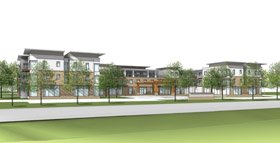
SAHA is also the developer behind Manzanita Family Apartments, an affordable housing project of 51 units to be located at 2951 Soscol Avenue in Napa. SAHA has completed its community outreach among neighbors and is now working closely with the city to wrap up the approval process, which is expected soon.
“This was a surplus piece of land belonging to the city that wasn’t needed after we completed construction of a new traffic intersection [old and new SOSCOL split],” explains Rick Tooker, community development director for the City of Napa. “SAHA’s application for design review was submitted a few months ago, and together the city and SAHA have worked with the neighborhood on building consensus early in the review process, addressing issues such as parking, privacy and aesthetics. This makes for a smoother permit review process.”
Initially, Levine says, a few nearby residents were skeptical of SAHA’s plans for the property, which is bordered on one side by an older residential neighborhood and with a newer neighborhood nearby. “We conducted a large open house for the neighbors and then had smaller work sessions to listen to their concerns. They were respectful in listening to our proposal, and I hope felt that their voices were being heard. That’s healthy, to be invested in your neighborhood.”
One initial concern of nearby residents was the close proximity of the three-story building to busy Soscol Avenue. “An early version of the design had front doors facing Soscol, but people were worried about the children who would live there being too close to traffic,” says Levine. “We’ve [since] flipped the design so the courtyard is now more protected.”
Manzanita Family Apartments will consist of one-, two-, and three-bedroom units. Once approvals are secured this spring and financing in place later this year, SAHA anticipates breaking ground on the project in mid 2018. The general contractor for the project, estimated to cost $25 million in total development costs, will be Chico-based Sunseri Construction.
SAHA will explore LEED certification of the Manzanita apartments from the U.S. Green Building Council, according to Levine. LEED (Leadership in Energy and Environmental Design) is an independent, third-party verification that a building, home or community was designed and built for exceptional water savings, energy efficiency and indoor environmental quality.
Aging-in-place option
To address the need for more senior housing in Napa, a large project is on target to break ground later this year along Solano Avenue on 5.8 acres of land adjacent to and owned by Justin-Siena High School. Called Napa Valley Senior Care and developed by Minnesota-based Oppidan Investment Company, the facility will consist of approximately 195,000 square feet of independent and assisted-living housing, as well as a memory-care section.
The high school is developing the land in part to increase its tuition assistance fund. Oppidan spokesperson Shannon Rusk says the site for the future senior home and care center is currently a grassy playing field.
“The facility will be almost like a country club, with amenities such as a fitness center, beauty salon, spa, and a cafe open to the public. It will be a great location for seniors to age in place,” she says. “Because it’s on the high school campus, we are looking at creating collaborations––some intergenerational programs––between the students and the seniors.”
Rusk forecasts construction will begin this fall. Once open, the facility will be operated by Watermark, an Arizona-based company that runs several other senior facilities in the Bay Area. Approximately 73 of the units are designed as independent-living rooms and another 73 units will be located in the assisted-living section. The memory-care unit is designed to house up to 21 patients living with dementia.
The development will be rented at market rate, says Rusk, with no low-income units planned.
Still, Oppidan will contribute toward the future building of low-income housing by paying an affordable housing impact fee to the city, according to Tooker. “Developers of some projects are required to pay our affordable housing impact fee, because many private-sector developments such as this have an impact on our affordable housing needs,” he explains. “So they pay the city to offset those impacts, and we use that money to leverage grants from the state or the federal government. The goal is to then build new affordable housing with our nonprofit partners.”
SAHA’s Levine says the City of Napa has put a lot of effort into studying the lack of affordable housing and finding solutions. “Napa is facing a terrible housing affordability crisis. But the reality is, because of the competitiveness of financing affordable housing, the subsidy required from the local level has grown bigger and bigger, so communities without those resources are at a disadvantage.”
Calistoga apartments
At the north end of the valley, construction of the Calistoga Senior Apartments was expected to get underway in February at 611 Washington Street. The 30 units in the three-story building will be rented only to seniors age 62 and older whose household incomes range from 30 to 60 percent of the Area Median Income (AMI).
“We are excited to have secured all the necessary funding for this project and plan on starting construction this quarter,” said Justin Hardt in January. Hardt is executive vice president of Woodland Hills-based Corporation for Better Housing (CBH), the developer of the project.
Last year at this time the Calistoga City Council agreed to a 75-year lease on the land where the apartments will be built, for which CBH, a nonprofit organization, will pay $1 per year. Part of the council’s approval included a title “cleanup,” says Hardt, that did away with the non-existent Fir Street that dated back to a map created in the 19th century. “The street had been approved in concept and recorded against the site. So half of this ‘paper’ street was eliminated in the title process.”
There was only minor opposition to the project when it was first proposed. “We received one negative letter from a resident living near the site, but that person didn’t show up at the public hearing and didn’t bring it up to us again,” says Lynn Goldberg, planning and building director for the City of Calistoga. “It’s an older area, on a vacant site of less than an acre. Various proposals for it had come up over the years, but nothing gelled.”
CBH also built the Calistoga Family Apartments at 1715 Washington Street, which opened in April 2015 for low-income agricultural workers. That project was made possible in part by a $3 million loan from the U.S. Department of Agriculture’s 514 Farm Labor Housing Program. The low-income affordable housing program dictates that residents who are the head of household or co-head must be in the agriculture industry. “It’s not necessarily limited to farmworkers, but a large majority of the residents are employed by the wine industry,” says Hardt.
Last year, the Calistoga Family Apartments received LEED Platinum certification for energy efficiency. The apartments also picked up a Gold Nugget Net-Zero Design Award because it offsets 100 percent of the onsite energy demand. “The development is generating as much electricity as it uses through numerous solar panels,” Hardt says. “It’s also a 100 percent electric site, so there is no carbon footprint.”
Goldberg says the Calistoga Family Apartments project turned out well and has “definitely filled a need.” Fully rented from the day it opened, there’s also a “very healthy waiting list” for the apartments, according to Hardt.
The success of that project paved the way for city approval of CBH’s senior apartments, he adds. “We were able to secure a second development in Calistoga based on the precedent and effort we put into the first one.”
Available land
The city would like to attract more housing developers, but it’s been difficult. “I’ve been reaching out to market rate developers and affordable housing developers about getting more housing built in Calistoga. One of the roadblocks has been the lack of available sites. We have vacant land, but some property owners are holding out for commercial projects.”
She’s concerned that local landowners are only interested in attracting more resorts. “Honestly, if we had any more resorts, I don’t know where their employees would come from. Who will staff these fine establishments? They require a lot of bodies.”
Going Up Soon
Housing projects in Napa County in various stages of approval, planning and construction include:
Calistoga Senior Apartments, 611 Washington St., Calistoga –– 30 units in a single three-story building for seniors age 62 and older, with household incomes as low as 45 percent of AMI (area median income). Construction began in February.
Valley View Affordable Senior Apartments, 31 Theresa Ave., American Canyon –– 70 cottage-style units for very low and extremely low-income seniors and veterans age 55 and over, with income levels 30 to 60 percent of AMI. Construction is expected to begin in April.
Napa Valley Senior Care, along Solano Avenue in Napa –– 173 rooms to be rented at market rate, divided into independent-living rooms and assisted-living rooms, and with a memory-care unit. Approved by the city last year, the developer intends to break ground this fall.
Manzanita Family Apartments, 2951 Soscol Ave., Napa –– 51 units in a single three-story building for families with income levels 30 to 60 percent of AMI. Community outreach by the developer has been completed, and city approval of the project is expected soon.
Napa Courtyards, 535 Coombsville Rd., Napa –– 20 units for families earning 30 to 60 percent AMI. Approved by the city in February 2016, construction has not yet begun.
Author
-

Jean Doppenberg is a lifelong journalist and the author of three guidebooks to Wine Country.
View all posts


